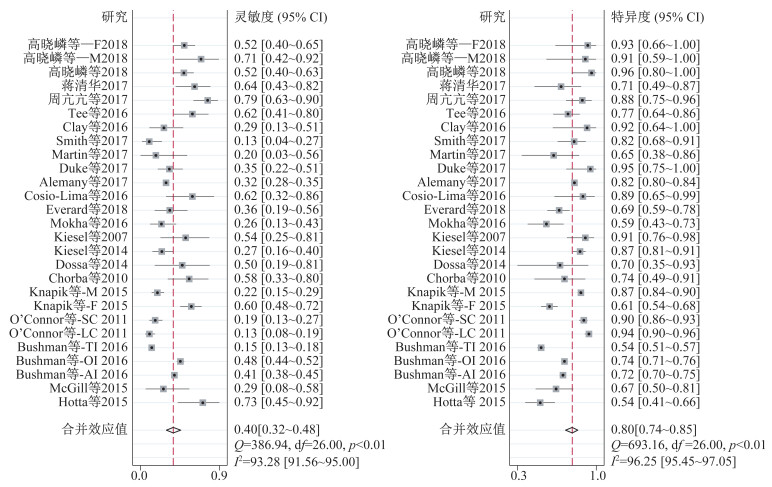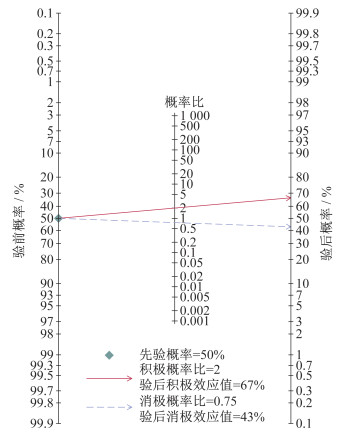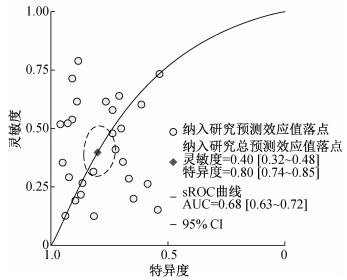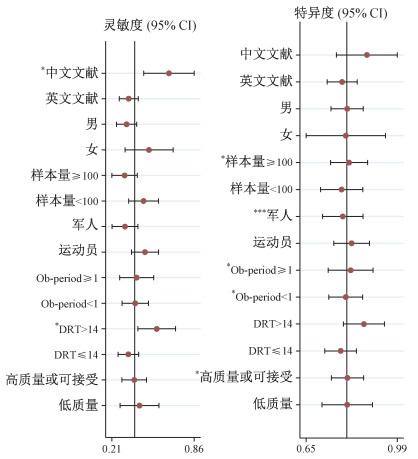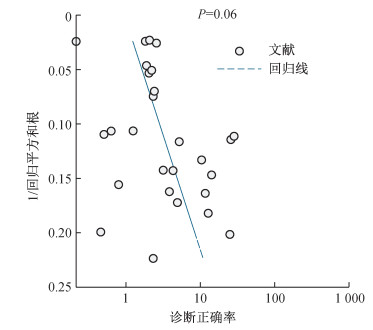Feasibility of Functional Movement Screen in Predicting Sports Injury: A Meta Analysis of Prospective Cohort Study
-
摘要:目的 运用meta分析的方法系统性回顾功能性动作筛查(functional movement screen,FMS)对运动损伤的预测效果。方法 运用STATA 15.0软件的MIDAS模块对纳入的21篇中英文文献的27组数据的真阳性数、假阳性数、真阴性数、假阴性数进行提取,对灵敏度、特异度的合并效应值进行估计,并利用汇总受试者操作特征(summary receiver operating characteristic,sROC)曲线的曲线下面积(area under curve,AUC)和Fagan列线图估计FMS的诊断准确度。采用单因素meta回归对异质性来源进行分析,通过Deeks'漏斗图不对称试验检验发表偏倚。结果 灵敏度的合并效应值为0.40[95%置信区间(95%CI)0.32~0.48],特异度的合并效应值为0.80(95%CI 0.74~0.85),灵敏度和特异度Q检验的P < 0.01,表明均存在一定异质性。正、负概率比的汇总预测试概率为50%,得出的正、负测试概率分别为67%和43%,AUC值为0.68(95%CI 0.63~0.72),均说明诊断准确性一般。对于灵敏度,文献类型和损伤风险阈值可能是异质性来源(P < 0.05);对于特异度,样本量、观察周期、文献质量、研究对象可能是异质性来源(P < 0.05)。Deeks'漏斗图显示纳入的21篇文献P=0.06 < 0.1,说明可能存在发表偏倚。结论 FMS综合评分与运动损伤之间关联强度的证据水平不足以支持其可以直接作为运动损伤的预测工具。Abstract:Objective Meta-analysis was used to systematically review the predictive effect of functional movement screen(FMS) on sports injury.Methods The MIDAS module of STATA 15.0 software was used to estimate sensitivity and specificity of 21 Chinese and Enghish literatures as well as 27 groups of data including true positive, false positive, true negative and false negative values, and to aggregate the summary receiver operating characteristic(sROC), area under curve (AUC) and Fagan nomogram to estimate the diagnostic accuracy of FMS. The sources of heterogeneity were analyzed by meta-regression analysis.Deeks' funnel diagram asymmetry test was used to test publication bias.Results The combined value of sensitivity is 0.40 (95% CI 0.32-0.48), and the combined effect value of specificity is 0.80 (95% CI 0.74-0.85). The P values of sensitivity and specificity Q test are less than 0.01, indicating some heterogeneity. The aggregate predictive test probability of positive/negative likelihood ratio (LR) is 50%, and the positive/negative test probability 67% and 43% respectively, the AUC 0.68 (95% CI 0.63-0.72), all indicating a general diagnostic accuracy. For sensitivity, literature type and injury risk thresholds may be sources of heterogeneity (P < 0.05). For specificity, sample size, observation period, literature quality, and study object may be sources of heterogeneity (P < 0.05). Deeks' funnel plot showed that P=0.06 < 0.1 for the 21 included literatures, indicating the possible existence of publication bias.Conclusion The evidence level of correlation strength between FMS comprehensive score and subsequent injury is insufficient to support the idea that FMS comprehensive score can be directly used as a tool for sports injury prediction.
-
Keywords:
- functional movement screen /
- sports injury /
- meta-analysis /
- prospective cohort study
-
运动损伤经常出现在体育运动特别是大运动量、高强度及低水平有氧运动中[1],易受影响的群体包括不同项目(足球、橄榄球、篮球等)的运动员[2-5]。由于与运动相关的伤害经常发生,预测伤害的形成可能会对伤害发生的频率和相关成本造成影响[6-7]。许多学科的研究人员投入时间和精力记录运动损伤的过程,分析特定伤害的危险因素[8-9],确定最容易遭受伤害的人群[10],并制定应对风险的干预措施[11]。功能性动作筛查(functional movement screen,FMS)是一种筛选测试,其目的是识别运动中的动作能力缺陷,这些缺陷可能会导致健康的人在运动中更易受伤[12-15]。FMS由7项运动任务和3项额外的排除测试组成,使用标准化的视觉观察体系进行评估[16-17],在临床中得到了广泛的应用、研究与关注[16-19]。
FMS是一种评估运动链中运动补偿的工具。在确定特定类型的运动模式后,FMS被用于描述这些感知补偿的练习[13]。由于其易用性和客观性,FMS的使用范围已扩大到多种体育模式[20]及军事环境[21-22]。针对缺乏其他评估方法的群体FMS的应用很有吸引力。FMS评估的主要目标是检测运动模式的变化,以指导个体采取有针对性的预防措施[12]。然而,FMS评估也有主观性缺点,关于正常运动模式的概念目前也未达成共识[20-23],且运动员的性别、年龄、运动项目等也应在运动损伤预测中被考虑。
此外,关于FMS作为运动损伤筛查手段在信度和效度方面的后续研究存在不同结果[24-30]。检索发现,国外共有4篇关于FMS预测运动损伤价值的meta分析论文[19, 31-33]:Bonazza等[19]的研究结论支持FMS对损伤有预测价值。Bunn等[33]认为,通过FMS被归类为高风险的个体受伤的概率较被归类为低风险的个体高51%,但证据水平非常低。然而,Dorrel等[31]的研究结论与之不同,认为FMS预测损伤的诊断准确度较低。Moran等[32]也认为,FMS综合评分与后续损伤之间的相关性并不支持其可作为损伤预测工具。目前,国内还没有已发表的关于FMS预测运动损伤价值的meta分析研究成果。
在meta分析中,文献的纳入标准决定了纳入文献的数量、种类和质量,在对同一问题进行分析时,纳入不同类型的文献将会对结论产生很大影响。本文与以上4篇meta分析论文[19, 31-33]相比,纳入文献标准有2个优势:①纳入文献的科学性更强。与横断面研究相比,前瞻性队列研究是提升FMS预测运动损伤准确性更有利的研究方法,而本文纳入的文献都是前瞻性队列研究。②纳入文献的范围更广。作为一篇综述类论文,纳入文献的广泛性和全面性直接影响文献的科学性和实效性,而本文无论是文献检索的时间范围还是检索的数据库范围都更加广泛。在上述4篇关于FMS预测运动损伤价值的meta分析论文中,研究方法均不是诊断实验系统评价的方法流程,且结论不一致,而本文采取了不同的文献纳入标准,研究价值可能更高。
1. 研究方法
1.1 文献检索策略
以循证医学Cochrane协作网中制定的临床检索方法与检索策略为依据[34]24-49,在中国知网(CNKI)、万方数据知识服务平台、维普网、中国科学引文索引数据库进行中文文献检索,在PubMed、Google Scholar、Scopus(包含ScienceDirect和Embase)、EBSCOhos(包含Academic Search Complete、AMED、CINAHL、Health Source和SPORTDiscus)和Cochrane Review数据库进行英文文献检索,检索时间范围为2006年1月1日至2019年4月30日。
在CNKI数据库中,以“主题(功能性动作筛查)并且主题(运动损伤)”或“主题(功能动作测试)并且主题(运动损伤)”或“主题(FMS)并且主题(运动损伤)”为检索式进行高级检索,共检索出文献223篇。
在万方数据知识服务平台数据库中,共检索出文献232篇(检索式同CNKI)。
在中国科学引文索引数据库中,共检索出文献3篇(检索式同CNKI)。
在维普网数据库中,以(M=功能性动作筛查OR功能动作测试OR FMS)AND(M=运动损伤)为检索式进行高级检索,共检索出文献30篇。
在EBSCOhos数据库中,以摘要(“FMS” OR “Functional Movement Screen”)AND(Predict OR Prediction)AND(Injury)为检索式进行检索,共检索出文献89篇。
在Scopus数据库中,以(TITLE-ABS(FMS)OR TITLE-ABS(Functional Movement Screen))AND(TITLE-ABS(injury predict)OR TITLE-ABS(predictive value)OR TITLE-ABS(injury predictive value))为检索式进行高级检索,共检索出文献258篇。
在PubMed数据库中,以(“Functional Movement Screen”[Title/Abstract] OR “FMS”[Title/Abstract])AND(“Injury Predict*”[Title/Abstract] OR “Predictive Value”[Title/Abstract] OR “Injury Predictive Value”[Title/Abstract])为检索式进行高级检索,共检索出文献91篇。
在Cochrane Review数据库中,以Title-abstract-keyword(FMS)and(Title-abstract-keyword(injury)or Title-abstract-keyword(predict))为检索式进行高级检索,共检索出文献56篇。
在Google Scholar数据库中,以Title(FMS)AND Title(injury)为检索式进行检索,共检索出文献52篇。
1.2 文献纳入标准
① 在同行评议期刊上发表的中英文文献。②前瞻性队列研究文献。③FMS综合得分被用于定义损伤风险。④能推算出或2×2列表中直接给出真阳性数、假阳性数、真阴性数、假阴性数数据的文献。最后对符合纳入标准的文献的参考文献进行手工筛查,以确保未遗漏其他相关文献。
1.3 文献筛选及数据提取
1.3.1 文献筛选
首先按照文献检索策略的步骤在各数据库中检索文献,并对文献进行收集整理;然后按上述纳入标准对文献的标题、摘要、关键词进行初步筛查,对每一项相关研究进行审查和评估,使用制定的纳入标准进行定性和定量分析;最后对筛选的文献进行定性和定量分析。文献的选择是无盲的,所有确定的文献都被详细阅读和审查,以验证纳入标准。
1.3.2 数据提取
对所纳入的文献进行数据提取和录入,包括第一作者、发表年份、研究对象、性别、年龄、样本量、失访人数、观察周期、损伤风险阈值、受伤类型及真阳性数、假阳性数、真阴性数、假阴性数等。
1.4 质量评价
在系统评价中评估单个样本的方法学质量是提高“实现有效结果”可能性的关键过程。目前关于方法学质量的评估没有金标准。虽然Cochrane协作网的诊断实验系统推荐采用诊断准确性研究的质量评价(quality assessment of diagnostic accuracy studies,QUADAS)清单评价诊断实验的方法学质量[34]73-74,但在Cochrane诊断测试准确性系统评价手册中了解到QUADAS清单主要针对横断面研究,本文纳入文献均为前瞻性队列研究,因此选择Q-Coh(队列研究质量评价)对选定研究的方法学质量进行评估。Q-Coh是一种具有“可接受”有效性和可靠性的工具,专门用于评估前瞻性队列研究中的偏倚风险[35]。当没有或只有1个域的评价是负面时,认为整体质量较高;如果有2个域的评价是负面时,认为整体质量可接受;如果有2个以上域的评价是负面的,则认为总体质量较低。
1.5 统计学分析
所有纳入研究的特征均由2位作者提取。本文用2×2列表整理测试结果的阳性或阴性数据。为了直观地评估不同研究间的特异度,使用STATA 15.0软件中的MIDAS模块制作森林图呈现结果,并使用95%置信区间(95% confidence interval,95%CI)的汇总受试者操作特征(summary receiver operating characteristic,sROC)曲线的曲线下面积(area under curve,AUC)反映诊断结果的准确性。此外,本文还通过生成Fagan列线图,检测验前概率和验后概率的差异,其中,验前概率为目标情况的发生率,验后概率=似然比率×概率/[(1-验前概率)×(1-似然比率)]。森林图中统计学异质性的评估使用χ2检验(P < 0.1为显著,P < 0.01为绝对显著),用I2衡量异质性大小。
进行敏感性分析以确定meta分析的稳定性,并探讨灵敏度和特异度潜在异质性的来源。以性别(男或女)、样本量(≥100或 < 100)、研究对象(军人或运动员)、观察周期(≥1 a/1赛季或 < 1 a/1赛季)、损伤风险阈值(是否为14分)、文章质量(高质量、可接受或低质量)为95%CI的协变量进行单因素meta回归分析。
2. 研究结果
2.1 纳入文献情况
在所选的4个中文、5个英文数据库中共检索到相关文献1 034篇,其中英文文献546篇、中文文献488篇。通过阅读摘要和标题排除文献865篇,通过全文阅读排除文献135篇,排除重复文献13篇,最终纳入文献21篇,包括中文文献3篇、英文文献18篇。文献纳入流程见图 1。
2.2 纳入文献基本特征
本文共纳入21篇中英文文献(表 1),共涉及5 963名参与者,其中:Tee等[36]的研究中62名受试者共接受测试90次,存在重复测试的现象;其他文献受试者均只接受过1次测试。研究对象为各种运动项目的运动员或军人;年龄为13~57岁,主要集中在18~25岁;由于运动员和军人的职业特性,受试者以男性为主;研究周期均在1 a以内;受伤的定义在不同文献、不同运动项目、不同人群中各不相同,大致分为创伤性损伤、非创伤性损伤、过度使用损伤、骨骼肌肉损伤和严重损伤。
表 1 纳入文献特征Table 1. Characteristics of included literatures作者(年份) 男 女 样本量 失访人数 年龄/岁 研究对象 观察周期 损伤风险阈值/分 受伤定义 TP FP FN TN 备注 Hotta等[37](2015) 101 0 84 17 20.0±1.1 大学田径运动员 6个月 ≤14 TL(≥4周)、创伤除外 11 32 4 37 McGill等[23](2015) 53 0 53 NR 37.9±5 特遣部队精英警察 5 a ≤14 除旅行、滑倒、摔倒和其他意外引起的背伤 4 13 10 26 Bushman等[21](2016) 2 476 0 2 476 590 18~57 轻步兵旅(美国陆军) 6个月 ≤14 由于过度使用引起的受伤并且寻求医生帮助 308 283 442 743 AI 256 335 278 937 OI 110 481 612 573 TI O'Connor等[38](2011) 874 0 874 NR(0) 长周期:23.0±2.6,短周期:21.7±2.6 美国海军陆战队军官候选人 68 d:n=447;38 d:n=427 ≤14 由于过度使用引起的受伤并且寻求医生帮助 19 17 131 260 LC 23 34 97 293 SC Knapik等[39](2015) 770 275 1 045 NR 18±0.7 美国海岸警卫队学员 8周 男≤14, 女≤11 任何损伤并寻求医生帮助 41 80 27 127 女 31 80 112 547 男 Chorba等[24](2010) 0 38 38 0 19±1.2 大学生三大球运动员 1个赛季 ≤14 寻求医生帮助 11 5 8 14 Dossa等[25](2014) 31 0 31 11 16~20 少年冰球运动员 1个赛季 ≤14 TL(≥1次比赛) 5 3 5 7 Kiesel等[40](2014) 238 0 238 NR NR 职业足球运动员 1个赛季 ≤14 肌肉骨骼损伤(不包括挫伤)导致训练或季前赛的任何时间损失 16 24 44 154 Kiesel等[41](2007) 46 0 46 NR(0) NR 职业足球运动员 约4.5个月 ≤14 TL(≥3周)的严重损伤 7 3 6 30 Mokha等[42](2016) 20 64 84 NR(0) 男:20.4±1.3,女:19.1±1.2 大学足球、排球、橄榄球运动员 1学年 ≤14 ①由于参加校内练习、力量训练或比赛而造成的损伤;②需要治疗或就医的;③由于受伤而进行了至少24 h的康复训练,或需要进行保护性夹板或胶带包扎,以便继续参加体育活动 10 19 28 27 Everard等[43](2018) 132 0 132 NR 22.4±4.2 男性新兵 16周 ≤14 TL(≥1次训练) 10 32 18 72 Cosio-Lima等[44](2016) 31 0 31 NR 28±4 男性海事安全应变考生 2个月 ≤14 由训练造成的任何损伤 8 2 5 16 Alemany等[1](2017) 2 153 0 2 134 19 25±1.3 男兵 6个月 ≤14 需就医的过度使用所致的骨骼肌肉损伤及运动创伤 221 260 479 1 174 Duke等[45](2017) 73 0 68 5 22.0±3.0 男子橄榄球联盟球员 3个月 ≤14 比赛或训练所导致的任何身体不适 17 1 31 19 Martin等[46](2017) 27 0 27 NR(0) 13~18 高中板球运动员 1个赛季 ≤14 TL(≥1 d)、任何身体损伤 2 6 8 11 Smith等[47](2017) 89 0 89 NR(0) 23.2±4.4 优秀男子足球运动员 1个赛季 ≤14 TL(非接触性损伤) 5 9 35 40 Clay等[48](2016) 0 37 37 NR(0) 18岁以上 女大学生一级赛艇运动员 1个赛季 ≤14 TL(≥1 d) 7 1 17 12 Tee等[36](2016) NR NR 62(重复测试) NR(0) NR 职业橄榄球联盟球员 6个月 ≤13 TL(≥28 d)的严重损伤 16 15 10 49 周亢亢等[49](2017) 19 62 81 NR(0) NR 中国高水平乒乓球运动员 将近0.5 a ≤12 满足以下①②中的1条,同时满足③④。①在训练或队内比赛(队内循环、队内教学赛等)中因运动损伤连续缺席正常技战术训练课和体能训练课1周;②在赛季中因运动损伤连续缺席2场以上(包括2场)超级联赛或公开赛;③运动员就自己出现的伤病情况寻求医务保障人员的帮助;④伤病是在训练或比赛中发生的 30 5 8 38 蒋清华[50](2017) NR NR 49 NR(0) 20.04±1.55 泉州市高校中长跑运动员 1 a ≤16 任何损伤或疼痛 16 7 9 17 高晓嶙等[51](2017) 28 90 118 0 女:20.2±2.8,男:21.1±2.9 现役国家队、省队橄榄球运动员 1 a 女≤13.5,男≤15.5 ①除直接接触以外的其他机制引起的;②需要医疗干预;③导致1 d或多天不能参加与运动有关的活动 42 1 39 24 总体 10 1 4 10 男 35 1 32 13 女 注:年龄数据以平均数±标准差形式表示;NR表示未明确报道;NR(0)表示若未明确报告失访人数,但可从结果推断,则括号内数字为失访人数;TL表示损失训练或比赛的时间,从公布的信息看,损伤的定义并不明确;TP表示真阳性数;FP表示假阳性数;FN表示假阴性数;TN表示真阴性数;AI表示轻度损伤;OI表示中度损伤;TI表示重度损伤;LC表示长周期训练;SC表示短周期训练。 2.3 纳入文献质量评价结果
2名作者分别使用Q-Coh中的7个阈共26项(另加5个初始项目)进行文献质量评价,对产生分歧的阈交由另1名作者进行评判,得出最终的文献质量评判结果(表 2)。
表 2 队列研究质量评价Table 2. Quality evaluation form for cohort studies作者(年份) 样本代表性 组间比较 风险量度 可比性的保持 结果测量 被试参与完整性 总体质量 Hotta等[37](2015) * ** ** ** ** ** 高质量 McGill等[23](2015) * ** ** * ** ** 可接受 Bushman等[21](2016) ** ** ** ** ** ** 高质量 O'Connor等[38](2011) ** ** ** ** ** ** 高质量 Knapik等[39](2015) ** * ** * ** ** 可接受 Chorba等[24](2010) * * ** * ** ** 低质量 Dossa等[25](2014) * * ** * ** ** 低质量 Kiesel等[40](2014) * * ** * ** ** 低质量 Kiesel等[41](2007) * * ** * ** ** 低质量 Mokha等[42](2016) * * ** * ** ** 低质量 Everard等[43](2018) ** * ** ** ** ** 高质量 Cosio-Lima等[44](2016) * * ** * ** ** 低质量 Alemany等[1](2017) ** * ** * ** ** 可接受 Duke等[45](2017) * * ** * * ** 低质量 Martin等[46](2017) * * ** * * ** 低质量 Smith等[47](2017) * ** ** * ** ** 可接受 Clay等[48](2016) * ** ** ** ** ** 高质量 Tee等[36](2016) * ** ** ** ** * 可接受 周亢亢等[49](2017) * ** ** ** ** ** 高质量 蒋清华[50](2017) * ** ** * * ** 低质量 高晓嶙等[51](2017) * * ** ** ** ** 可接受 注:*表示不满足;**表示满足。 2.4 meta分析结果
2.4.1 诊断准确性分析
森林图(图 2)显示了纳入文献的FMS对运动损伤诊断的灵敏度和特异度。森林图的异质性以Q检验确定,以P<0.1表明异质性较为明显。共纳入21篇文献的27组数据,其中灵敏度和特异度Q检验的P < 0.01,表明均存在一定的异质性,灵敏度的合并效应值为0.40(95%CI 0.32~0.48),特异度的合并效应值为0.80(95%CI 0.74~0.85)。图 3中FMS的Fagan列线图左侧是验前概率,右侧是验后概率。结果表明,正、负概率比的汇总预测试概率为50%,得出的正、负测试概率分别为67%和43%。除此之外,还绘制了sROC曲线并计算了纳入研究的AUC值(图 4)。sROC曲线的纵轴表示灵敏度(真阳性率),横轴表示假阳性率(1-特异度),变化界限值时两者的变化成一曲线。AUC值越大诊断准确度越高,0.7 > AUC值>0.5表示准确度较低,AUC值为0.7~0.9表示准确度一般,AUC值>0.9表示准确度较高。AUC值=0.5时说明诊断方法完全不起作用,即无诊断价值。本文的AUC值为0.68(95%CI 0.63~0.72),说明诊断准确度较低。
2.4.2 异质性来源分析
由于FMS的灵敏度和特异度的汇总结果之间存在显著异质性(图 2),对灵敏度进行亚组分析。对纳入研究的可能影响异质性的因素(文献类型、研究对象、性别、样本量、观察周期、损伤风险阈值、文献质量)进行单因素meta回归分析,结果如图 5所示。对于灵敏度,文献类型和损伤风险阈值可能是异质性来源(P<0.05);对于特异度,样本量、观察周期、文献质量、研究对象可能是异质性来源(P<0.05)。
2.4.3 发表偏倚
Deeks’漏斗图不对称试验评估结果(图 6)显示,纳入21篇文献的P=0.06<0.1,说明可能存在发表偏倚或其他影响因素。
3. 讨论
近年来,伴随着运动竞赛对抗性的日益增加及业余健身活动的普及,运动损伤发生率也在不断提高。在不断探索基于运动表现或运动能力预测运动损伤的方法及模式时,FMS作为一种测试工具受到了业界的广泛关注,但其对运动损伤预测的有效性一直饱受争议,至今学术界尚未赋予该工具一个明确的定位。这种状况不仅与FMS自身的特点有关,还与不同研究者的研究方法及视角紧密相关。因此,对FMS高质量研究成果进行严谨分析,归纳其共同点意义重大。本文作为一篇系统综述,在研究方法上弥补了前人研究的不足;在文献的纳入方面选择前瞻性队列研究,更契合FMS的预测性特征。本文丰富了FMS预测运动损伤的价值理论,进一步归纳了FMS对运动损伤的预测效果,深入探讨了FMS的价值,为现实中运动损伤的诊断和预防手段的选取提供了参考。本文与前人研究相比纳入了中文文献,所以研究结果更贴近FMS在我国运用的现实状况,可为我国运动员运动损伤的诊断和预防提供参考。
在本文中,FMS提供了较高特异度(0.80)和较低灵敏度(0.40),这说明FMS高得分者发生运动损伤的概率较小,但低得分者拥有高运动损伤风险并未得到很好的证明。这间接说明FMS是一项动作模式的检测,运动损伤的产生除了动作模式外还与关节灵活性、力量、柔韧性、环境、场地、运动装备等有关。运动损伤的产生是多因素综合作用的结果,这是FMS整体灵敏度较低的主要原因。在sROC曲线中,AUC值为0.68,说明FMS的整体预测准确度偏低。正、负概率比的汇总预测试概率为50%,得出的正、负测试概率分别为67%和43%,这证明了FMS对运动损伤有一定预测能力,但预测成功率一般。
异质性分析表明,文献类型和损伤风险阈值是影响灵敏度的因素。样本量、观察周期、文献质量及研究对象是影响特异度的因素。文献类型对灵敏度的影响具体表现在中文文献的灵敏度高于英文文献的灵敏度[0.66(95%CI 0.46~0.86)vs. 0.34(95%CI 0.27~0.42)],这可能与纳入中文文献数量及研究对象少、研究对象种族不同等有关。损伤风险阈值对灵敏度的影响具体表现在,以≤14分为评判标准时的灵敏度低于不以≤14分为评判标准时的灵敏度[0.34(95%CI 0.26~0.42)vs. 0.56(95%CI 0.41~0.71)],主要原因是不以≤14分为评判标准的文献均采用受试者操作特征曲线及其坐标图来确定损伤风险阈值,以≤14分为评判标准的文献中有的借鉴前人的研究成果,这都可能影响研究结果,导致可信度较低。研究对象对特异度的影响最强,其中军人的特异度低于运动员的特异度[0.78(95%CI 0.71~0.86)vs. 0.82(95%CI 0.75~0.88)],这一结果提示,FMS在不同领域的适用性有所不同,对运动员的预测损伤效果优于军人。
FMS作为一种运动损伤的预测工具,需要对运动损伤进行严格定义并在特定情况下使用,否则在不同运动项目、运动环境、运动量等一系列因素影响下可能会得出不同的结论。本文对Bushman等[21]研究中3种运动损伤类型,O’Connor等[38]研究中长、短观察周期,以及Knapik等[39]、高晓嶙等[51]研究中不同性别人群的数据进行了提取与分类,这也导致了不同研究背景、不同研究人群、不同运动损伤定义条件下,FMS作为一种损伤风险预测工具并没有很好的预测效果。
目前国外已发表的4篇FMS预测损伤风险的meta分析论文得出了2种不同的结论:Bonazza等[19]没有对方法学质量进行评估,也没有对纳入文献的类型(前瞻性队列研究或横断面研究)进行分类,且将所有研究纳入了meta分析;Dorrel等[31]采用QUADAS清单评价诊断实验的方法学质量,得出的结论是FMS预测损伤的诊断准确度较低。本文使用Q-Coh方法对纳入研究的方法学质量进行评估,Q-Coh是一种具有“可接受”有效性和可靠性的工具,专门用于评估前瞻性队列研究中的偏倚风险,尽管与Dorrel等[31]研究的结论大致相同,但Dorrel等[31]所包含的研究质量较低,其有效性受到质疑。其他2篇meta分析论文设定了诸多异质性来源,对所选文献进行分类探索,最终的结论也都是FMS作为损伤预测工具并不是在任何条件下都适用[32-33]。
本文在评判FMS预测运动损伤时,主要有以下3个优点:①无论是文献检索的时间范围还是检索数据库的范围,纳入的文献更广泛;②纳入文献都是前瞻性队列研究,科学性更强;③使用专门用于评估前瞻性队列研究偏倚风险的Q-Coh方法,对纳入研究的方法学质量进行评估,针对性更强。但本文也存在以下不足:①纳入的文献仅是中、英文文献,数据不够全面;②纳入的文献大多未提及或讨论其各自研究的任何盲法或试图盲法;③研究对象以男性为主,女性只占少数,在今后的研究中性别比例有待优化;④国内对FMS预测损伤的实验类文献较少,前瞻性研究更是寥寥无几,对本文纳入文献的质量有很大影响。
4. 结论
FMS综合评分与运动损伤之间关联强度的证据水平不足以支持其可以直接作为运动损伤的预测工具。FMS综合评分在准确界定运动损伤、针对特性研究人群、损伤风险阈值不固定的情况下才能更好地预测运动损伤。
作者贡献声明:束拉:提出论文选题,设计研究方案,核实、处理数据,撰写论文;陈国壮:搜集、阅读相关文献,提取、处理数据,撰写、修改论文。 -
表 1 纳入文献特征
Table 1 Characteristics of included literatures
作者(年份) 男 女 样本量 失访人数 年龄/岁 研究对象 观察周期 损伤风险阈值/分 受伤定义 TP FP FN TN 备注 Hotta等[37](2015) 101 0 84 17 20.0±1.1 大学田径运动员 6个月 ≤14 TL(≥4周)、创伤除外 11 32 4 37 McGill等[23](2015) 53 0 53 NR 37.9±5 特遣部队精英警察 5 a ≤14 除旅行、滑倒、摔倒和其他意外引起的背伤 4 13 10 26 Bushman等[21](2016) 2 476 0 2 476 590 18~57 轻步兵旅(美国陆军) 6个月 ≤14 由于过度使用引起的受伤并且寻求医生帮助 308 283 442 743 AI 256 335 278 937 OI 110 481 612 573 TI O'Connor等[38](2011) 874 0 874 NR(0) 长周期:23.0±2.6,短周期:21.7±2.6 美国海军陆战队军官候选人 68 d:n=447;38 d:n=427 ≤14 由于过度使用引起的受伤并且寻求医生帮助 19 17 131 260 LC 23 34 97 293 SC Knapik等[39](2015) 770 275 1 045 NR 18±0.7 美国海岸警卫队学员 8周 男≤14, 女≤11 任何损伤并寻求医生帮助 41 80 27 127 女 31 80 112 547 男 Chorba等[24](2010) 0 38 38 0 19±1.2 大学生三大球运动员 1个赛季 ≤14 寻求医生帮助 11 5 8 14 Dossa等[25](2014) 31 0 31 11 16~20 少年冰球运动员 1个赛季 ≤14 TL(≥1次比赛) 5 3 5 7 Kiesel等[40](2014) 238 0 238 NR NR 职业足球运动员 1个赛季 ≤14 肌肉骨骼损伤(不包括挫伤)导致训练或季前赛的任何时间损失 16 24 44 154 Kiesel等[41](2007) 46 0 46 NR(0) NR 职业足球运动员 约4.5个月 ≤14 TL(≥3周)的严重损伤 7 3 6 30 Mokha等[42](2016) 20 64 84 NR(0) 男:20.4±1.3,女:19.1±1.2 大学足球、排球、橄榄球运动员 1学年 ≤14 ①由于参加校内练习、力量训练或比赛而造成的损伤;②需要治疗或就医的;③由于受伤而进行了至少24 h的康复训练,或需要进行保护性夹板或胶带包扎,以便继续参加体育活动 10 19 28 27 Everard等[43](2018) 132 0 132 NR 22.4±4.2 男性新兵 16周 ≤14 TL(≥1次训练) 10 32 18 72 Cosio-Lima等[44](2016) 31 0 31 NR 28±4 男性海事安全应变考生 2个月 ≤14 由训练造成的任何损伤 8 2 5 16 Alemany等[1](2017) 2 153 0 2 134 19 25±1.3 男兵 6个月 ≤14 需就医的过度使用所致的骨骼肌肉损伤及运动创伤 221 260 479 1 174 Duke等[45](2017) 73 0 68 5 22.0±3.0 男子橄榄球联盟球员 3个月 ≤14 比赛或训练所导致的任何身体不适 17 1 31 19 Martin等[46](2017) 27 0 27 NR(0) 13~18 高中板球运动员 1个赛季 ≤14 TL(≥1 d)、任何身体损伤 2 6 8 11 Smith等[47](2017) 89 0 89 NR(0) 23.2±4.4 优秀男子足球运动员 1个赛季 ≤14 TL(非接触性损伤) 5 9 35 40 Clay等[48](2016) 0 37 37 NR(0) 18岁以上 女大学生一级赛艇运动员 1个赛季 ≤14 TL(≥1 d) 7 1 17 12 Tee等[36](2016) NR NR 62(重复测试) NR(0) NR 职业橄榄球联盟球员 6个月 ≤13 TL(≥28 d)的严重损伤 16 15 10 49 周亢亢等[49](2017) 19 62 81 NR(0) NR 中国高水平乒乓球运动员 将近0.5 a ≤12 满足以下①②中的1条,同时满足③④。①在训练或队内比赛(队内循环、队内教学赛等)中因运动损伤连续缺席正常技战术训练课和体能训练课1周;②在赛季中因运动损伤连续缺席2场以上(包括2场)超级联赛或公开赛;③运动员就自己出现的伤病情况寻求医务保障人员的帮助;④伤病是在训练或比赛中发生的 30 5 8 38 蒋清华[50](2017) NR NR 49 NR(0) 20.04±1.55 泉州市高校中长跑运动员 1 a ≤16 任何损伤或疼痛 16 7 9 17 高晓嶙等[51](2017) 28 90 118 0 女:20.2±2.8,男:21.1±2.9 现役国家队、省队橄榄球运动员 1 a 女≤13.5,男≤15.5 ①除直接接触以外的其他机制引起的;②需要医疗干预;③导致1 d或多天不能参加与运动有关的活动 42 1 39 24 总体 10 1 4 10 男 35 1 32 13 女 注:年龄数据以平均数±标准差形式表示;NR表示未明确报道;NR(0)表示若未明确报告失访人数,但可从结果推断,则括号内数字为失访人数;TL表示损失训练或比赛的时间,从公布的信息看,损伤的定义并不明确;TP表示真阳性数;FP表示假阳性数;FN表示假阴性数;TN表示真阴性数;AI表示轻度损伤;OI表示中度损伤;TI表示重度损伤;LC表示长周期训练;SC表示短周期训练。 表 2 队列研究质量评价
Table 2 Quality evaluation form for cohort studies
作者(年份) 样本代表性 组间比较 风险量度 可比性的保持 结果测量 被试参与完整性 总体质量 Hotta等[37](2015) * ** ** ** ** ** 高质量 McGill等[23](2015) * ** ** * ** ** 可接受 Bushman等[21](2016) ** ** ** ** ** ** 高质量 O'Connor等[38](2011) ** ** ** ** ** ** 高质量 Knapik等[39](2015) ** * ** * ** ** 可接受 Chorba等[24](2010) * * ** * ** ** 低质量 Dossa等[25](2014) * * ** * ** ** 低质量 Kiesel等[40](2014) * * ** * ** ** 低质量 Kiesel等[41](2007) * * ** * ** ** 低质量 Mokha等[42](2016) * * ** * ** ** 低质量 Everard等[43](2018) ** * ** ** ** ** 高质量 Cosio-Lima等[44](2016) * * ** * ** ** 低质量 Alemany等[1](2017) ** * ** * ** ** 可接受 Duke等[45](2017) * * ** * * ** 低质量 Martin等[46](2017) * * ** * * ** 低质量 Smith等[47](2017) * ** ** * ** ** 可接受 Clay等[48](2016) * ** ** ** ** ** 高质量 Tee等[36](2016) * ** ** ** ** * 可接受 周亢亢等[49](2017) * ** ** ** ** ** 高质量 蒋清华[50](2017) * ** ** * * ** 低质量 高晓嶙等[51](2017) * * ** ** ** ** 可接受 注:*表示不满足;**表示满足。 -
[1] ALEMANY J A, BUSHMAN T T, GRIER T, et al. Functional movement screen: Pain versus composite score and injury risk[J]. J Sci Med Sport, 2017, 20: S40-S44 http://europepmc.org/abstract/MED/28919122
[2] BARDENETT S M, MICCA J J, DENOYELLES J T, et al. Functional movement screen normative values and validity in high school athletes: Can the fmsTM be used as a predictor of injury?[J]. Int J Sports Phys Ther, 2015, 10(3): 303-308 http://europepmc.org/articles/PMC4458917
[3] BOND C W, DORMAN J C, ODNEY T O, et al. Evaluation of the functional movement screen and a novel basketball mobility test as an injury prediction tool for collegiate basketball players[J]. J Strength Cond Res, 2019, 33(6): 1589-1600 doi: 10.1519/JSC.0000000000001944
[4] GADZIŃSKI S, MASŁOŃ A, CZECHOWSKA D, et al. Assessment of fundamental movement patterns and risk of injury in male soccer players[J]. Physiotherapy, 2017, 24(2): 13-18 http://www.degruyter.com/view/j/physio.2017.24.issue-2/physio-2016-0008/physio-2016-0008.xml?rskey=W1xmWn&result=6
[5] SCHRÖDER J, WELLMANN K, BRAUMANN K M. Der functional movement screen zur verletzungsvorhersage im männer-amateurfußball[J]. Deut Z Sportmed, 2016(2): 39-43 http://www.zeitschrift-sportmedizin.de/fileadmin/content/archiv2016/Heft_2/Schroeder_Erweitertes_Abstract.pdf
[6] JUNGE A, LAMPRECHT M, STAMM H, et al. Countrywide campaign to prevent soccer injuries in Swiss amateur players[J]. Am J Sports Med, 2011, 39(1): 57-63 doi: 10.1177/0363546510377424
[7] ORCHARD J W. Preventing sports injuries at the national level: Time for other nations to follow New Zealand's remarkable success[J]. Br J Sports Med, 2008, 42(6): 392-393 doi: 10.1136/bjsm.2008.047472
[8] LEETUN D T, IRELAND M L, WILLSON J D, et al. Core stability measures as risk factors for lower extremity injury in athletes[J]. Med Sci Sports Exerc, 2004, 36(6): 926-934 doi: 10.1249/01.MSS.0000128145.75199.C3
[9] ZAZULAK B T, HEWETT T E, REEVES N P, et al. Deficits in neuromuscular control of the trunk predict knee injury risk: A prospective biomechanical-epidemiologic study[J]. Am J Sports Med, 2007, 35(7): 1123-1130 doi: 10.1177/0363546507301585
[10] HÄGGLUND M, WALDÉN M, EKSTRAND J. Previous injury as a risk factor for injury in elite football: A prospective study over two consecutive seasons[J]. Br J Sports Med, 2006, 40(9): 767-772 doi: 10.1136/bjsm.2006.026609
[11] SUGIMOTO D, MYER G D, FOSS K D, et al. Dosage effects of neuromuscular training intervention to reduce anterior cruciate ligament injuries in female athletes: Meta- and sub-group analyses[J]. Sports Med, 2014, 44(4): 551-562 doi: 10.1007/s40279-013-0135-9
[12] COOK G, BURTON L, HOOGENBOOM B. Pre-participation screening: The use of fundamental movements as an assessment of function: part 2[J]. N Am J Sports Phys Ther, 2006, 1(3): 132-139 http://www.ncbi.nlm.nih.gov/pubmed/21522225
[13] COOK G, BURTON L, HOOGENBOOM B. Pre-participation screening: The use of fundamental movements as an assessment of function: part 1[J]. N Am J Sports Phys Ther, 2006, 1(2): 62-72 http://www.zhangqiaokeyan.com/academic-journal-foreign-pmc_international-journal-sports-physical-therapy_thesis/040001797993.html
[14] COOK G, BURTON L, HOOGENBOOM B J, et al. Functional movement screening: The use of fundamental movements as an assessment of function: part 1[J]. Int J Sports Phys Ther, 2014, 9(3): 396-409 http://www.ncbi.nlm.nih.gov/pubmed/21522225
[15] COOK G, BURTON L, HOOGENBOOM B J, et al. Functional movement screening: The use of fundamental movements as an assessment of function: part 2[J]. Int J Sports Phys Ther, 2014, 9(4): 549-563 http://www.ncbi.nlm.nih.gov/pubmed/21522225
[16] MCCALL A, CARLING C, DAVISON M, et al. Injury risk factors, screening tests and preventative strategies: A systematic review of the evidence that underpins the perceptions and practices of 44 football (soccer) teams from various premier leagues[J]. Br J Sports Med, 2015, 49(9): 583-589 doi: 10.1136/bjsports-2014-094104
[17] WRIGHT A A, STERN B, HEGEDUS E J, et al. Potential limitations of the functional movement screen: A clinical commentary[J]. Br J Sports Med, 2016, 50(13): 770-771 doi: 10.1136/bjsports-2015-095796
[18] MORAN R W, SCHNEIDERS A G, MAJOR K M, et al. How reliable are functional movement screening scores? A systematic review of rater reliability[J]. Br J Sports Med, 2016, 50(9): 527-536 doi: 10.1136/bjsports-2015-094913
[19] BONAZZA N A, SMUIN D, ONKS C A, et al. Reliability, validity, and injury predictive value of the functional movement screen: A systematic review and meta-analysis[J]. Am J Sports Med, 2017, 45(3): 725-732 doi: 10.1177/0363546516641937
[20] MCCUNN R, AUS DER FÜNTEN K, FULLAGAR H H, et al. Reliability and association with injury of movement screens: A critical review[J]. Sports Med, 2016, 46(6): 763-781 doi: 10.1007/s40279-015-0453-1
[21] BUSHMAN T T, GRIER T L, CANHAM-CHERVAK M, et al. The functional movement screen and injury risk: Association and predictive value in active men[J]. Am J Sports Med, 2016, 44(2): 297-304 doi: 10.1177/0363546515614815
[22] LISMAN P, O'CONNOR F G, DEUSTER P A, et al. Functional movement screen and aerobic fitness predict injuries in military training[J]. Med Sci Sports Exerc, 2013, 45(4): 636-643 doi: 10.1249/MSS.0b013e31827a1c4c
[23] MCGILL S, FROST D, LAM T, et al. Can fitness and movement quality prevent back injury in elite task force police officers? A 5-year longitudinal study[J]. Ergonomics, 2015, 58(10): 1682-1689 doi: 10.1080/00140139.2015.1035760
[24] CHORBA R S, CHORBA D J, BOUILLON L E, et al. Use of a functional movement screening tool to determine injury risk in female collegiate athletes[J]. N Am J Sports Phys Ther, 2010, 5(2): 47-54 http://europepmc.org/articles/PMC2953387
[25] DOSSA K, CASHMAN G, HOWITT S, et al. Can injury in major junior hockey players be predicted by a pre-season functional movement scree: A prospective cohort study[J]. J Can Chiropr Assoc, 2014, 58(4): 421-427 http://www.ncbi.nlm.nih.gov/pubmed/25550667
[26] FROST D M, BEACH T A, CALLAGHAN J P, et al. FMS scores change with performers' knowledge of the grading criteria-are general whole-body movement screens capturing "dysfunction"?[J]. J Strength Cond Res, 2015, 29(11): 3037-3044 doi: 10.1097/JSC.0000000000000211
[27] FROST D M, BEACH T A C, CALLAGHAN J P, et al. Using the functional movement screenTM to evaluate the effectiveness of training[J]. J Strength Cond Res, 2012, 26(6): 1620-1630 doi: 10.1519/JSC.0b013e318234ec59
[28] KAZMAN J B, GALECKI J M, LISMAN P, et al. Factor structure of the functional movement screen in marine officer candidates[J]. J Strength Cond Res, 2014, 28(3): 672-678 doi: 10.1519/JSC.0b013e3182a6dd83
[29] WARREN M, SMITH C A, CHIMERA N J. Association of the functional movement screen with injuries in division Ⅰ athletes[J]. J Sport Rehabil, 2015, 24(2): 163-170 doi: 10.1123/jsr.2013-0141
[30] WHITESIDE D, DENEWETH J M, POHORENCE M A, et al. Grading the functional movement screen: A comparison of manual (real-time) and objective methods[J]. J Strength Cond Res, 2016, 30(4): 924-933 doi: 10.1519/JSC.0000000000000654
[31] DORREL B S, LONG T, SHAFFER S, et al. Evaluation of the functional movement screen as an injury prediction tool among active adult populations: A systematic review and meta-analysis[J]. Sports Health, 2015, 7(6): 532-537 doi: 10.1177/1941738115607445
[32] MORAN R W, SCHNEIDERS A G, MASON J, et al. Do functional movement screen (FMS) composite scores predict subsequent injury? A systematic review with meta-analysis[J]. Br J Sports Med, 2017, 51(23): 1661-1669 doi: 10.1136/bjsports-2016-096938
[33] BUNN P D S, RODRIGUES A I, BEZERRA DA SILVA E. The association between the functional movement screen outcome and the incidence of musculoskeletal injuries: A systematic review with meta-analysis[J]. Phys Ther Sport, 2019, 35: 146-158 doi: 10.1016/j.ptsp.2018.11.011
[34] 刘鸣. 系统评价、Meta-分析设计与实施方法[M]. 北京: 人民卫生出版社, 2012 [35] JARDE A, LOSILLA J M, VIVES J, et al. Q-Coh: A tool to screen the methodological quality of cohort studies in systematic reviews and meta-analyses[J]. Int J Clin Heal Psychol, 2013, 13(2): 138-146 doi: 10.1016/S1697-2600(13)70017-6
[36] TEE J C, KLINGBIEL J F, COLLINS R, et al. Preseason functional movement screen component tests predict severe contact injuries in professional rugby union players[J]. J Strength Cond Res, 2016, 30(11): 3194-3203 doi: 10.1519/JSC.0000000000001422
[37] HOTTA T, NISHIGUCHI S, FUKUTANI N, et al. Functional movement screen for predicting running injuries in 18-to 24-year-old competitive male runners[J]. J Strength Cond Res, 2015, 29(10): 2808-2815 doi: 10.1519/JSC.0000000000000962
[38] O'CONNOR F G, DEUSTER P A, DAVIS J, et al. Functional movement screening: Predicting injuries in officer candidates[J]. Med Sci Sports Exerc, 2011, 43(12): 2224-2230 doi: 10.1249/MSS.0b013e318223522d
[39] KNAPIK J J, COSIO-LIMA L M, REYNOLDS K L, et al. Efficacy of functional movement screening for predicting injuries in coast guard cadets[J]. J Strength Cond Res, 2015, 29(5): 1157-1162 doi: 10.1519/JSC.0000000000000704
[40] KIESEL K B, BUTLER R J, PLISKY P J. Prediction of injury by limited and asymmetrical fundamental movement patterns in American football players[J]. J Sport Rehabil, 2014, 23(2): 88-94 doi: 10.1123/JSR.2012-0130
[41] KIESEL K, PLISKY P J, VOIGHT M L. Can serious injury in professional football be predicted by a preseason functional movement screen?[J]. N Am J Sports Phys Ther, 2007, 2(3): 147-158 http://pubmedcentralcanada.ca/pmcc/articles/PMC2953296/
[42] MOKHA M, SPRAGUE P A, GATENS D R. Predicting musculoskeletal injury in national collegiate athletic association division Ⅱ athletes from asymmetries and individual-test versus composite functional movement screen scores[J]. J Athl Train, 2016, 51(4): 276-282 doi: 10.4085/1062-6050-51.2.07
[43] EVERARD E, LYONS M, HARRISON A J. Examining the association of injury with the functional movement screen and landing error scoring system in military recruits undergoing 16 weeks of introductory fitness training[J]. J Sci Med Sport, 2018, 21(6): 569-573 doi: 10.1016/j.jsams.2017.05.013
[44] COSIO-LIMA L, KNAPIK J J, SHUMWAY R, et al. Associations between functional movement screening, the Y balance test, and injuries in coast guard training[J]. Mil Med, 2016, 181(7): 643-648 doi: 10.7205/MILMED-D-15-00208
[45] DUKE S R, MARTIN S E, GAUL C A. Preseason functional movement screen predicts risk of time-loss injury in experienced male rugby union athletes[J]. J Strength Cond Res, 2017, 31(10): 2740-2747 doi: 10.1519/JSC.0000000000001838
[46] MARTIN C, OLIVIER B, BENJAMIN N. The functional movement screen in the prediction of injury in adolescent cricket pace bowlers: An observational study[J]. J Sport Rehabilitation, 2017, 26(5): 386-395 doi: 10.1123/jsr.2016-0073
[47] SMITH P D, HANLON M P. Assessing the effectiveness of the functional movement screen in predicting noncontact injury rates in soccer players[J]. J Strength Cond Res, 2017, 31(12): 3327-3332 doi: 10.1519/JSC.0000000000001757
[48] CLAY H, MANSELL J, TIERNEY R. Association between rowing injuries and the functional movement screenTM in female collegiate division Ⅰ rowers[J]. Int J Sports Phys Ther, 2016, 11(3): 345-349 http://europepmc.org/abstract/PMC/PMC4886802
[49] 周亢亢, 黄竹杭, 张璐, 等. 对中国高水平乒乓球运动员功能性动作筛查测试损伤风险阈值的应用研究[J]. 北京体育大学学报, 2017, 40(7): 112-119 https://www.cnki.com.cn/Article/CJFDTOTAL-BJTD201707018.htm [50] 蒋清华. 泉州市高校中长跑运动员FMS与运动损伤的相关性研究[J]. 四川体育科学, 2017, 36(6): 36-38 https://www.cnki.com.cn/Article/CJFDTOTAL-SCTK201706009.htm [51] 高晓嶙, 徐辉, 黄鹏, 等. 应用功能性动作测试评估我国橄榄球运动员损伤风险的研究[J]. 中国运动医学杂志, 2017, 36(5): 410-415 doi: 10.3969/j.issn.1000-6710.2017.05.005 -
期刊类型引用(19)
1. 唐煜淞,韩东辰,赵永魁. 功能性运动筛查与足球运动的关联性分析及应用. 当代体育科技. 2025(01): 1-4 .  百度学术
百度学术
2. 张娴,刘莉,孙俊,周晓斌. 探讨功能动作筛查对某部新训人员训练成绩提高及训练伤的预测意义. 创伤外科杂志. 2025(03): 166-170+185 .  百度学术
百度学术
3. 黄慧敏,曾喻容,徐海燕. 基于Meta分析的拇外翻足部矫形器的有效性探究. 皮革科学与工程. 2024(02): 84-90 .  百度学术
百度学术
4. 邢晓蕊,成玮,田海丽,徐炳祥,颜红梅,刘诚,孙钦,王汝雯,万康,张译尹,王茹. 糖尿病患者运动前测试与评估临床路径构建的经验启示与实现框架. 上海体育大学学报. 2024(05): 81-93 .  本站查看
本站查看
5. 田静静,王维涵,王美,郭振. 集体球类项目急慢性负荷比与损伤风险的meta分析. 福建师范大学学报(自然科学版). 2024(06): 121-129 .  百度学术
百度学术
6. 王耀东,董艳婷. 功能性训练对我国高水平女子体操运动员高低杠项目关节损伤的康复促进研究. 中国体育科技. 2024(10): 9-19 .  百度学术
百度学术
7. 桑园. 基于FMS的高校男子篮球运动员的运动损伤风险评估. 延边大学学报(自然科学版). 2024(04): 131-135 .  百度学术
百度学术
8. 张娜. 公路自行车运动员功能性动作筛查结果及纠正训练效果分析. 辽宁体育科技. 2023(01): 110-115 .  百度学术
百度学术
9. 马阳光,张永峰,邵玲娃,李松森,张颖如,莫惠霖,王哲,丁坦. 空军飞行人员功能性动作筛查结果分析. 联勤军事医学. 2023(02): 144-147 .  百度学术
百度学术
10. 张鑫,欧阳瑞楠. 军校学员运动损伤规律特征及其防控体系研究. 冰雪体育创新研究. 2023(04): 144-147 .  百度学术
百度学术
11. 任康,赵振东,任慧杰. 纠正性训练对排球运动员运动功能障碍影响的实验研究. 当代体育科技. 2023(09): 20-23 .  百度学术
百度学术
12. 冯雪,李赞,赵慧敏,常宇伟. 功能性动作筛查(FMS):争议、局限及拓展. 天津体育学院学报. 2023(03): 276-282+346 .  百度学术
百度学术
13. 黎宏业. 基于灰色关联分析法的消防员功能动作筛查与负重类体能测评项目关联度研究. 体育科技文献通报. 2023(05): 249-251+256 .  百度学术
百度学术
14. 王刚,宋永飞,胡绪,陈振,雷恩宇,孟涛. 军人身体关节功能筛查对新兵军事训练伤的预测效度研究. 陆军军医大学学报. 2023(20): 2189-2194 .  百度学术
百度学术
15. 于丹丹,马琼,李夏,张玉旋,肖军. 功能性动作筛查在预测运动损伤中的价值:基于诊断性试验的系统评价. 中国疗养医学. 2023(12): 1290-1296 .  百度学术
百度学术
16. 常硕. 散打运动员FMS测试成绩与力量素质的相关性研究. 拳击与格斗. 2022(01): 71-75 .  百度学术
百度学术
17. 张秋越. 功能性动作筛查(FMS)在高职男子篮球队中的应用研究. 体育视野. 2022(04): 98-100 .  百度学术
百度学术
18. 毛薇. 基于功能性动作筛查的高校健美操运动员运动损伤特征分析. 辽宁体育科技. 2022(04): 82-86 .  百度学术
百度学术
19. 余兆敏. 体育训练中运动损伤原因与恢复策略. 辽宁师专学报(自然科学版). 2021(04): 64-66 .  百度学术
百度学术
其他类型引用(24)




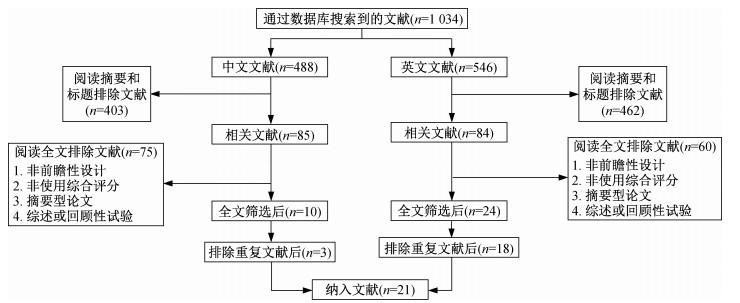
 下载:
下载:
